It was a late winter day, dreary. I couldn’t take it anymore, the meanness and stupidity, the incompetence and corruption revealed daily in the news, in Twitter storms, out of the mouths of two old men talking tabloid in the supermarket check-out line. Back home I looked for something to brighten my day – and found it in a Rio de Janeiro favela.
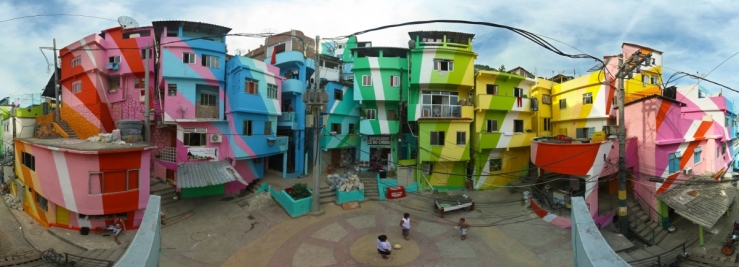
What I saw was the stunning photo above, a panoramic view of 34 brightly striped houses in Rio’s Santa Marta favela, the result of a project called “Praça Cantão” (2010). I wanted to know more, so I dug in.
It all began in 2005 when Dutch artists Dre Urhahn and Jeroen Koolhaas, who call themselves Haas&Hahn, came to Rio to make an MTV documentary on hip-hop music in the favelas. Non-favela Brazilians avoided the areas, viewing them (often rightly) as dangerous and lawless; tourists were warned not to enter one.
Haas&Hahn, however, witnessed the depth of creativity and optimism that ran through the favela and were dismayed by outsiders’ unfavorable opinions. So an idea came to them: What if the favelados painted their own neighborhoods in ways that portrayed them in a positive light? Could it change the negative stereotypes held by outsiders – and, in the process, change the conditions of the favelados themselves? (See “8 Years of Haas&Hahn,” 2013 video.)
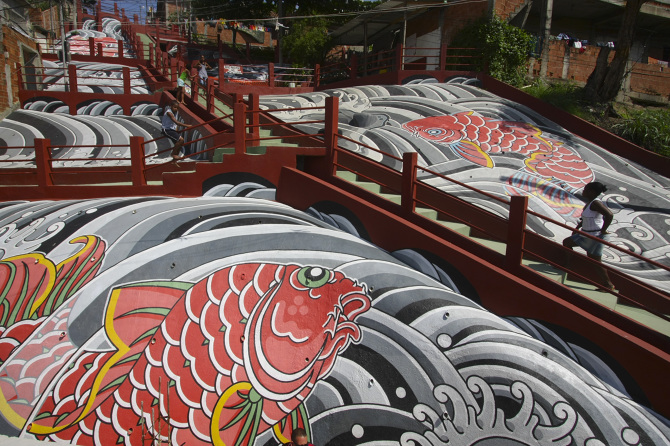
Their first two projects were in the Vila Cruzeiro neighborhood: “Boy with Kite” (2007) and “Rio Cruzeiro” (2008-09, above). For both they partnered with local youths, who were trained and paid. Given the success of these two projects, they decided to go bigger and bolder, creating Santa Marta’s “Praça Cantão.”
The Santa Marta project continues to draw international attention. Recently CNN and Australia’s Herald Sun placed it among the world’s most colorful places. Academics in a variety of disciplines – including sociology, anthropology, and architecture – have utilized aspects of Haas&Hahn projects in their urban studies research. And Haas&Hahn have received requests from other places in the Americas, as well as abroad, to bring the power of color to distressed neighborhoods.
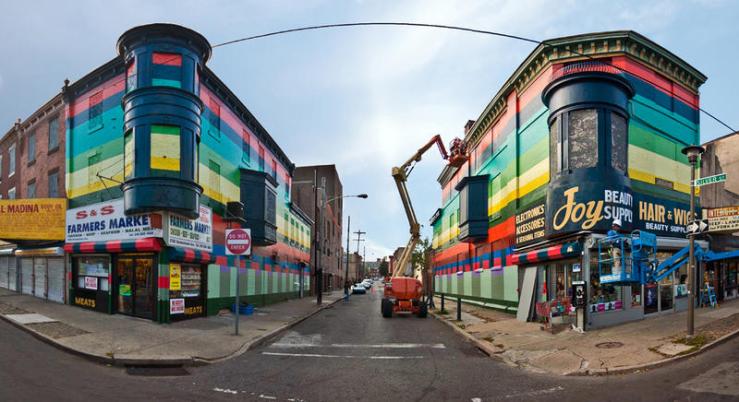
In 2012, for example, they brought their art to one of the poorest neighborhoods in the United States, North Philadelphia (photo above). There, as reported on NPR’s TED Radio Hour, local store and building owners and a team of about a dozen youths worked together for two years to paint 50 storefronts, transforming “their own neighborhood – the whole street – in a giant patchwork of color.”
On their Favela Painting Foundation website, Haas&Hahn explain why they create artworks with community involvement in “places where people are being socially excluded”:
“By collaborating with locals, art is used as a weapon to combat prejudice, create sustainability solutions and attract positive attention. By ensuring that each step of the creative process is open, collaborative, and community driven, Favela Painting can effectively contribute to the education and empowerment of the community, particularly local youth, installing a sense of pride and community ownership.”
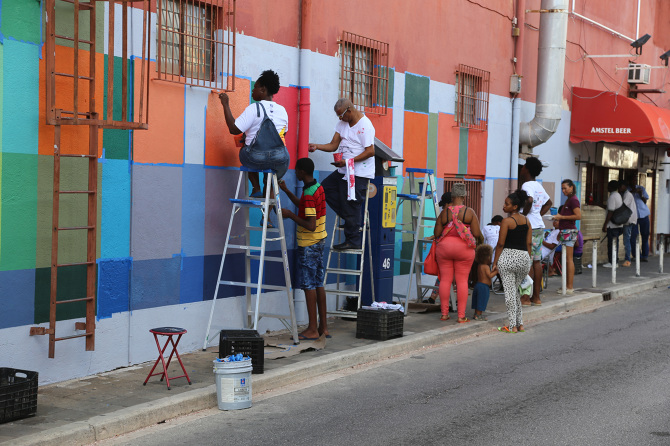
In other words, the transformations that distressed neighborhoods experience aren’t just aesthetic; they’re also personal, social, and economic. Haas&Hahn claim that the “projects bring hope, positivity, beauty, job opportunities and stability” (The Telegraph).
Supporting their claim, research at the Yale School of Medicine and other places indicates that public art “can lead to increased levels of community engagement and social cohesion,” serve “as a powerful catalyst for improved mental and physical health,” and improve “perceptions of both the pedestrian environment and neighborhood safety” (Center for Active Design) – especially when artists are teamed with neighborhood residents. Mural Arts Philadelphia’s Porch Light Program is a prime example.
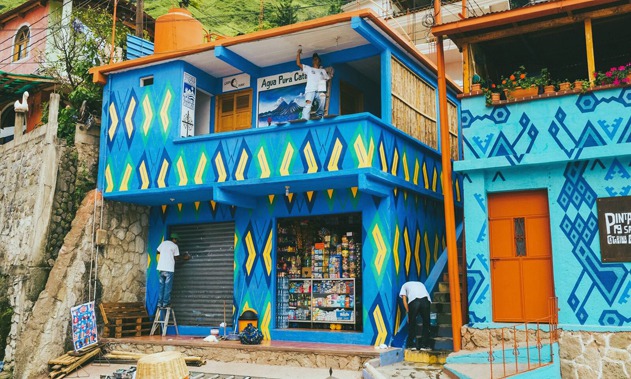
Another glowing example of community improvement through community-created public art is the ongoing project in Santa Catarina Palopó, Guatemala, on the shores of Lake Atitlán (example above). The goal is ambitious: to paint 960 buildings in the vibrant colors and designs of women’s traditional blouses. Over 35 buildings have been completed so far. And, according to Architectural Digest, the project “has already sparked development, job opportunities, pride, and empowerment in its 5,000 locals, plus increased cultural tourism awareness.”
Haas&Hahn’s Rio favela paintings inspired this project. In fact, they led an initial workshop in Santa Catarina, after which locals took over. Crucial to this entire project, say the promoters, is community involvement. For instance, community leaders approved the final color palette and design templates, and families of each home get to choose how their house will look from these options.
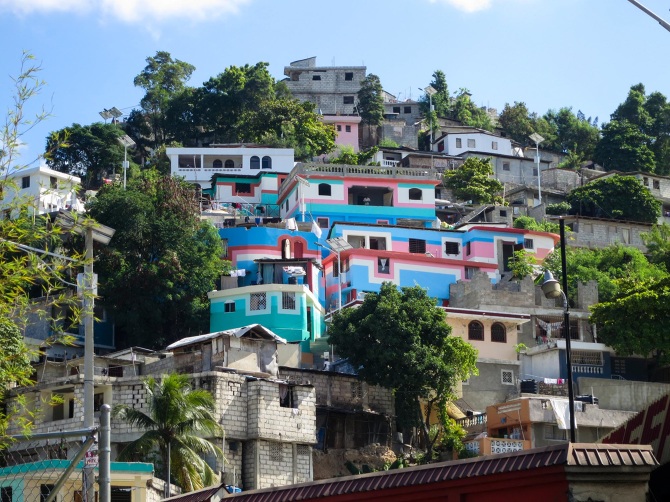
Other places where Haas&Hahn projects have brightened distressed communities include Miami’s Wynwood district (2014), Caribbean island Curaçao (2014, 2016), Port-au-Prince, Haiti (2015, above); and an Amsterdam prison converted into a hub for refugees (2016).
I don’t know what Haas&Hahn have lined up for 2018, but I did discover on Dre Urhahn’s Instagram page that this past December they finished another favela painting project in Rio. He wrote:
So hard to say goodbye to our second home, rua Santa Helena in Vila Cruzeiro. An amazing place, the coolest people and the best crew ever working on the latest #favelapainting project, colored walls, tiles, mosaic, turning the street into a place of magic. Hope to be back soon!!! Valeu
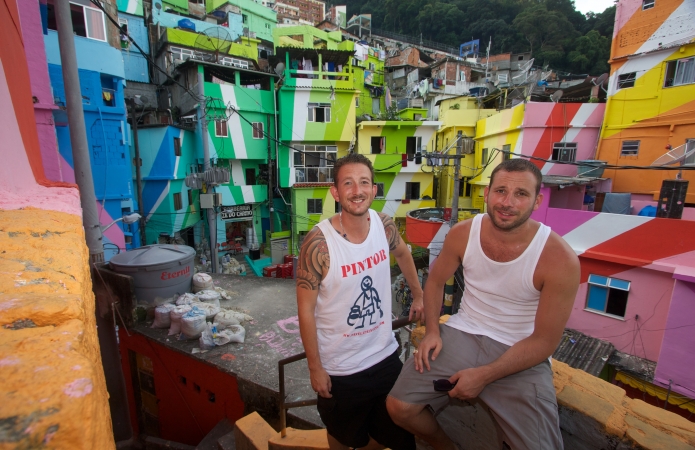
Photo Credits in order of presentation: “Praça Cantão” in Santa Marta favela; “Rio Cruzeiro” in Vila Cruzeiro favela; Philly Painting in North Philadelphia; Favela Painting Academy members at work on the island of Curaçao; Santa Catarina Palopó buildings with traditional Guatemalan designs; Haitian Painting in Port-au-Prince; Dre Urhahn and Jeroen Koolhaas in Rio’s Santa Marta.
# # #
